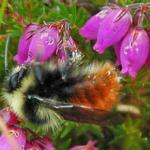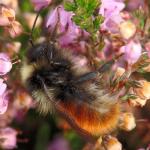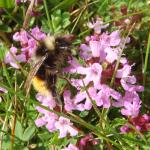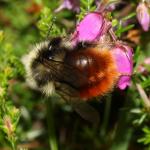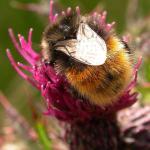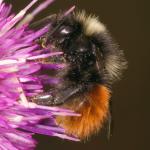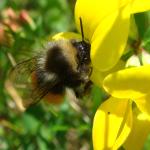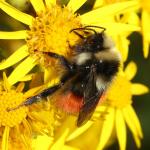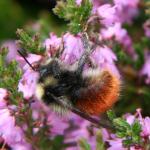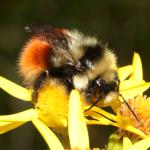For details see Williams Bumblebees of the World
A very distinctive bumblebee with extensive red marking over at least the last half of the abdomen, and a very bright yellow band on the front of the thorax. It is closely associated with higher altitude habitat and there may be some association with highland areas which support bilberries (Vaccinium spp.) It has also been recorded at sea-level in northern England and Scotland.
Historically, widely distributed throughout northern and western Britain and recently recorded from Ireland. There are very few records from south-eastern England, but it did formerly occur on the higher areas of the Weald near Hindhead in Surrey (specimen in Haslemere Museum collection). There is a marked decline in the distribution of this bumblebee throughout its former range in Britain. The species is boreo-alpine in western Europe only: northern and western Fennoscandia, the Pyrenees, northern Italy, the Alps and Balkan mountains. The closely related B. lapponicus has a more easterly distribution (Svensson 1979).
This bee was not regarded as being scarce or threatened, but has now been included on English Nature’s Species Recovery Programme because of the modern evidence of serious decline.
Associated with mountain and moorland habitat, although scarce in pure moorland areas. Recent research has shown a frequent connection with grassland habitats as well as moorland ones.
The species is eusocial, with queens emerging from hibernation in April; workers are present from May onwards, and males and new females from July to early October.
Nests are underground and are started in old mammal nests. Nest sizes are fairly small, and the colonies often have fewer than 50 workers. The life-cycle is also short, about 3-4 months.
There are clear flower-visiting preferences for this species, with bilberries (Vaccinium spp.) and sallow (Salix spp.) being much used in spring; bird’s-foot trefoil (Lotus corniculatus), clovers (Trifolium spp.) and raspberry (Rubus idaeus) and bramble (Rubus fruticosus agg.) in early to mid summer and bell heather (Erica cinerea) and bilberries in mid to late summer.
It is likely that this species is attacked by the socially parasitic bee, Bombus sylvestris.
Profile written:
Proofed: April 2012


